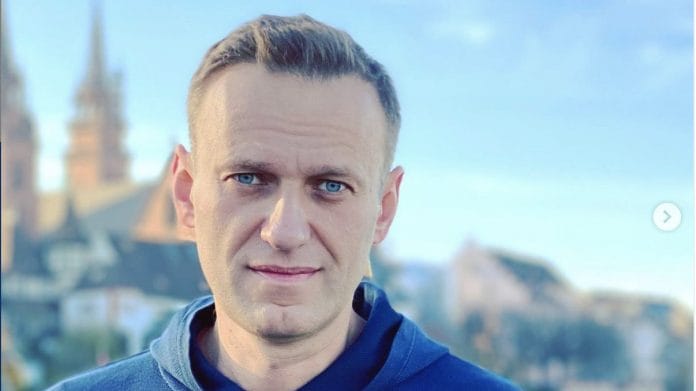“Don’t be afraid. Take to the streets,” Russian opposition leader Alexey Navalny appealed in a video this week from a police station on the outskirts of Moscow. “Don’t go out for me, go for yourself and for your future.”
It’s a compelling rallying call. After all, the loudest of President Vladimir Putin’s critics was stopped immediately upon returning home from Germany, where he had spent months recovering from a nerve-agent attack. Dozens of supporters who gathered to greet him were hauled away by police. Last Sunday was a reminder that any opposition voice, especially a persistent one, is a threat to be dealt with. Western remonstrances will be ignored.
That doesn’t mean mass protests will necessarily follow, even after Navalny released a feature-length film on an eye-poppingly ostentatious seaside mansion he says belongs to Putin. It’s garnered more than 50 million views since being posted on Tuesday, despite Kremlin denials. Yet practical hurdles and potential costs are high for anyone who joins unauthorized gatherings. A flurry of online calls for action in support of Navalny, especially among the TikTok generation, has prompted the communications watchdog to clamp down, and several of his high-profile allies have been detained.
More modest demonstrations are possible, though, and may well prove no less problematic for Putin, who has long based his rule on the perception of popular support. Any such crowds would show how far Navalny’s anti-corruption message resonates with economically squeezed, coronavirus-hit Russians. It’s a stand-off that could set the tone for the later years of Putin’s fourth — but not necessarily final — term.
The more autocratic a system becomes, the harder it is to challenge it with people power. Yet Russians have marched often in the last decade: in 2011 and 2012, after election irregularities and then-prime minister Putin’s job swap with Dmitry Medvedev to become president again; in 2017, after videos by Navalny’s organization that revealed the alleged extravagance of Putin’s inner circle and linked Medvedev to a property empire; in 2018, against pension reforms and in 2019 after anti-government candidates were barred from standing in Moscow city elections. Last year, there were months of protests in the far eastern city of Khabarovsk after the arrest of a popular regional governor.
Significantly, there’s been an increase in local issue-driven protests that are less obviously political — say, outrage in Yekaterinburg over plans to build a church in a much-loved park, in the far north over plans for a landfill, or in the central republic of Bashkortostan over a limestone mine. Some have even gotten results.
The question is whether Navalny can harness such dissatisfaction. He’s not the popular hero of Western imagination. A near-total blackout for him on state television makes it harder to touch older Russians. Government smear campaigns have left their trace: A Levada Centre poll last month found that nearly half of respondents who knew about his poisoning believed it to have been faked or a provocation engineered by the West.
Given the heavy-handed reactions since Navalny’s return, the authorities will probably keep up the pressure on Saturday, leaning on pandemic rules to keep crowds dispersed. They’ve already refused permission for gatherings in several cities. Detentions are likely to continue apace. No surprise, perhaps, given the network of former security and military officials around Putin who will consider only the need to preserve order, according to Tatiana Stanovaya of consultancy R.Politik, with little concern for the hazards that come with the excessive use of force.
That doesn’t mean there won’t be enough people out to irk the Kremlin, nor that they won’t persevere.
There’s what Lee Morgenbesser, at Griffith University in Australia, described to me as the effects of cumulative discontent, a powerful force. While there’s no rigged election to trigger action here, as there has been in the past or as seen recently in neighboring Belarus, there’s been a succession of events, building pressure over time: a shocking poisoning, an airport arrest captured live on social media, a hasty court hearing and then, topping it off, the images of a billion-dollar palace that could not contrast more sharply with the image of an austere, God-fearing workaholic that Putin likes to project.
All of that against the backdrop of falling incomes and a pandemic that has shone an unflattering light on threadbare regional budgets. Putin’s personal popularity is far from the lofty levels seen after Russia’s annexation of Crimea in 2014 triggered a wave of nationalist sentiment. Kremlin elites have shrugged off demonstrations in the past, but rarely have so many ingredients been in place at the same time.
Jan Matti Dollbaum at the University of Bremen in Germany, who studies Russian opposition and protests, points out that by playing on the grievances, Navalny and his supporters could in theory keep modest demonstrations going for a few months — at least until campaigning begins ahead of a legislative election in September. It would amplify his message and broaden the reach of his foundation’s smart voting efforts to defeat pro-Kremlin candidates, signaling that alternation is still possible in Russian politics. The stakes are rising.-Bloomberg
Also read: Russia jails Putin critic Navalny for 30 days, defying US, European calls to free him






